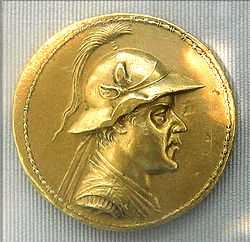Bactrian Gold



The Bactrian Treasure (also known as the Bactrian Gold or Bactrian Hoard) is a treasure cache that lay under the "Hill of Gold" (also known as the "Golden Hill", or Tillia tepe) in Afghanistan for 2,000 years until Soviet archaeologists exposed it shortly before the 1979 invasion. The hoard then went missing during subsequent wars in Afghanistan, until it was "rediscovered" and first brought to public attention again in 2003.
The hoard is a collection of about 20,600 gold ornaments that was found in six burial mounds near Sheberghan, in the northern Afghanistan province of Jowzjan, and was excavated in 1978 by a team led by the Greek-Russian archaeologist Viktor Sarianidi, a year before the Soviet invasion of Afghanistan. The ornaments include coins, necklaces set with gems, belts, medallions and crowns. A new museum in Kabul is being planned where the Bactrian gold will eventually be kept.
Some of the 20,000 pieces were displayed in the Guimet Museum in Paris in December 2006. Until then, the collection had never been displayed outside Afghanistan. The collection was later shown at Museo di Antichità in Turin, Italy, and then at the Nieuwe Kerk in Amsterdam before being moved to the National Gallery of Art in Washington D.C., where it was displayed alongside other ancient Afghan treasures in 2008.[1]
The hoard was thought to have been lost at some point in the 1990s, the National Museum of Afghanistan having been looted numerous times resulting in a loss of 70% of the 100,000 objects on display.[2] In 2003, however, it was found in secret vaults under the central bank building in Kabul.
In 1989 following a committee decision, the last Communist president of Afghanistan, Mohammad Najibullah had ordered the hoard moved from the museum to an underground vault at the Central Bank of Afghanistan in Kabul. The doors of the vault were locked with keys which were distributed to five trusted individuals.[2]
In 2003, after the Taliban was deposed, the new government wanted to open the vault, but the keyholders (called "tawadars") could not be summoned because their names were purposefully unknown. Hamid Karzai had to issue a decree authorizing the attorney general to go ahead with safecracking. But in time, the five key-holders were successfully assembled and the vault opened. Since then, the National Geographic Society has catalogued the collection, which appears to be complete – 22,000 objects. Also witnessing the re-opening were National Geographic Explorer and Archaeology Fellow Fredrik Hiebert and the archaeologist who originally found the hoard, Viktor Sarianidi.
The collection is particularly valuable to the Afghan people, as much of their heritage was looted from museums during the civil wars after the fall of the Soviet-backed regime.
Selected items from the collection toured the United States from May 25, 2008 to September 20, 2009, with exhibitions in Washington, D.C., San Francisco, Houston, New York City and Melbourne.[3]
Footnotes
- ↑ Afghanistan: Hidden Treasures from the National Museum, Kabul (2008), pp. 18-19.
- ↑ 2.0 2.1 Lawson, Alastair (1 March 2011). "Afghan gold: How the country's heritage was saved". BBC. Retrieved 1 March 2011.
- ↑ "Afghanistan: Hidden Treasures from the National Museum, Kabul"
References
- Sarianidi, V. I. "The Treasure of Golden Hill", American Journal of Archaeology, Vol. 84, No. 2 (April, 1980), pp. 125–131.
- Sarianidi, Victor. 1990–1992. "Tilya Tepe: The Burial of a Noble Warrior." PERSICA XIV, 1990–1992, pp. 103–130.
- "Afghanistan, les trésors retrouvés", Musée des arts asiatiques Guimet, ISBN 2-7118-5293-8
- Afghanistan: Hidden Treasures from the National Museum, Kabul (2008). Eds., Friedrik Hiebert and Pierre Cambon. National Geographic, Washington, D.C. ISBN 978-1-4262-0374-9.
- "L'Or De La Bactriane Fouilles De La Necropole De Tillia-Tepte." En Afghanistan Septentrional, Leningrad, Editions d'art Aurora, 1985
External links
| Wikimedia Commons has media related to Tillya Tepe. |
- Afghanistan: Hidden Treasures from the National Museum, National Gallery of Art, Washington, DC
- "Afghanistan: Nation Protects Storied Bactrian Treasure", from Radio Free Europe, June 9, 2006 – provides an overview.
- "Afghan golden treasure on display", from BBC News South Asia, December 6, 2006
- "Lost Treasures of Afghanistan Revealed ", from National Geographic, November 17, 2004